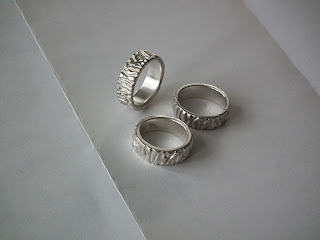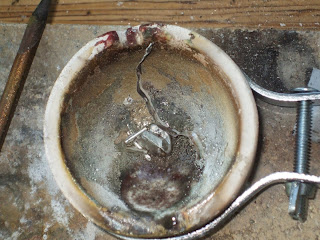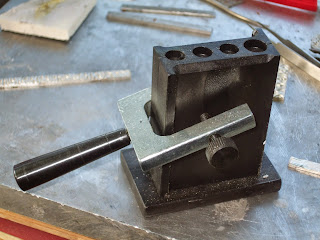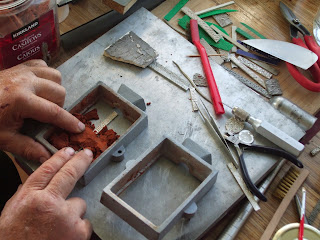I love the look of textured silver rings. Textured silver rings have a
cool modern and hip look to them. The natural shine of silver is accentuated by
the textured metal surface. One can were them anywhere and anytime; weddings, parties,
casual or formal occasions.
I have a shop called Aprilshower where I sell my rings and other jewelry. I wanted to show to those who are interested the process and handwork involved.
Fine silver
is 99.9% pure silver metal. Sterling silver, somewhat harder is 92.5% pure, cooper
makes up the rest. Both have their characteristics important for jewellery
makers.
I chose
fine silver because it has a beautiful white color no other metal has. I chose
fine silver also because I do some enamelled jewellery and the glass powder
used for enamelling melts somewhere between 1425 degrees F. and 1500 degrees F.
Fine silver
melts at 1761 degrees F ( 961 ºC. ). Sterling silver has a
lower melting point at 1640 degrees F ( 893 ºC. ). As you can see, sterling
has a melting point closer to the
melting temperature of glass.

Here is one
of my most liked rings that I will use as an example. Most
jewelers, if they want to add texture to their pieces, use the hammering
technique. Hammering is fine but it can not achieve the look I was looking for.
 |
| Crucible with some scrap silver. |
After some
trials and errors I resolved to use the casting technique. Casting necessitates a whole set of equipment and
material.
The first things I needed and had to make is a template of the future
ring. The one
thing I want to keep secret is how I make the first templates. The trials and
errors cost me quit a bit of money but you can possibly figure it out.
The second was to make a mould from that template in which the molten
silver is poured.
At this
stage I tried many techniques, made many errors and finally succeeded in using a tried methods that works, Delft sand casting.
Delft sand casting is a sand casting method for casting small objects without undercuts. Undercuts would make the template impossible to remove without braking the sand mold.
I have two different casting
moulds but the principle is the same.
Instead of pressing the template into the compacted sand like
demonstrated on many sites, technique that did not work well for my template, I
compact the sand around my template then remove the template. The second part
of the mould is filled up with compacted sand and the two parts are joined
together. The space between the two parts is filled
with molten silver. After unmoulding and cleaning, you get a rough template of
your future ring.






